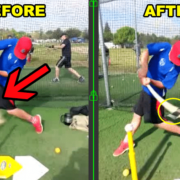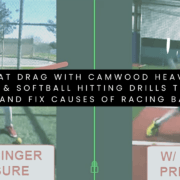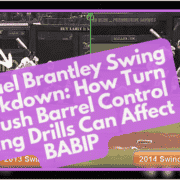Turning Vs Pushing The Barrel: Modern MLB Bat Path Swing Drills To Fix Misguided Baseball Or Softball Hitting
Discover turning vs pushing the barrel by looking at the modern MLB bat path from Andrew McCutchen. Learn drills to fix misguided baseball or softball hitting advice. Turning the barrel is fantastic for middle away and middle down pitches, while pushing the barrel is great for middle in versus middle up pitches, Click Here for a post I did on that.
Modern MLB Bat Path Swing Like Andrew McCutchen
In this video post, we’re going to talk about:
- Discuss when barring the front arm is okay,
- Explore the science of spinning fast vs slow,
- See how effective The Cutch is at turning, and
- Look at how to work on this at home.
CLICK HERE to watch the – 2 min, 5 second – PBS Circus Physics video about the Conservation of Angular Momentum, or turning faster.
Straightening the Front Arm Out…Good or Bad?
I’ve shifted my thoughts on this since doing this video back in 2014. I’d rather have my hitters bar their front arm out (or slight bend in front elbow) to and through contact. Click Here to watch an interview I did with Perry Husband of EffectiveVelocity.com about arm barring. This will answer all your questions on the topic.
SCIENCE-BASED TRAINING:
Improve your hitting strategy dramatically by applying human movement principles.
Learn not only how and what to train but also the science behind the methods.
The Science of Spinning Fast vs “Slow”
There are two Physics principles working with the Conservation of Angular Momentum:
- When an ice skater moves her arms in towards her center-line while spinning, then her turning speed goes UP, but inertial mass goes DOWN.
- And when an ice skater moves her arms away from her center-line while spinning, then her turning speed goes DOWN, but inertial mass goes UP.
What does this mean for hitters? Two additional things:
- Firstly, swing tempo means something. If you accelerate a small part without the big part, then the spinning top becomes wobbly.
- Secondly, you can’t “spin” faster and maximize force at contact, when inertial mass goes down.
- And thirdly, the longer front arm accomplishes the best of three worlds: it promotes healthy swing tempo, increases inertial mass (balancing turning speed), AND encourages predictability in barrel path because it keeps the front arm shape at a constant versus the inconsistent “bending” of the front elbow taught by a few.
Did Cutch Pass the Turning Speed Test?
In the above Andrew McCutchen baseball hitting video, science clearly says that ‘Cutch’ can in fact turn faster during his Final Turn.
However in this Andrew McCutchen baseball hitting video, he can get away with it because of his shorter arm span in comparison to a hitter with a longer one, like Miguel Cabrera. Cabrera would have to stand farther off the plate to make an early arm bar work. Similar to what Ken Griffey Jr. did.
And as we’ll discover what force bleeding compensation he makes – possibly – because of his early arm barring in Part-3 of the Andrew Mccutchen baseball hitting video: Do This For Longer Drives video series.
UPDATED NOTES: Cutch is doing just fine in this swing analysis. Just how it’s suppose to be 😉
How Do We Practice a Faster Turn at Home?
- Break the swing into two-steps: 1) To the Fight Position (Landing), and 2) the Final Turn
- Use a mirror or batting tee
- Video analysis feedback – either Coach’s Eye app (free for android) or Ubersense app (free for iphone)
- Hitter “hides their hands from the pitcher”, while keeping front arm straight or with a slight bend
- Going into the Final Turn, the hitter will try and “crush the proper catcher’s glove”
CLICK HERE for Part-3: Do This For Longer Drives: Andrew McCutchen baseball hitting video series, where we look to see if Cutch breaks the One-Joint Rule…If you missed Part-1, then CLICK HERE.
- Fix Your Child’s Fear of the Ball Fast: Proven Hitting Drills to Stop Flinching at Pitches—Trusted by Top Youth Baseball Coaches - July 12, 2025
- Fix Your Little Leaguer’s Hitting Slump Fast – Proven Confidence Drills & Mental Reset Tools (Used by Top Youth Baseball Coaches) - July 9, 2025
- Best Hitting Drills for 8-Year-Olds (2025): Fix Swing Flaws Fast with This MLB-Trusted Youth Baseball System—At-Home, Step-by-Step, and Built for Game-Day Confidence - July 5, 2025













I Enjoyed the info Joey.Thanks.
@Jonathan Austin: glad you like it, and thanks for reading/watching. More good information to come!
You nailed it Joey when you say the arms have to stay bent, and they have to stay compact until the player is well into their rotation. And … they shouldn’t start to straighten them out until at the very least, heel plant – and by then they should be way into the swing as well. Anything else and they will NEVER rotate to their maximum velocity.
Rotational velocity is the #1 component to a fast swing (with power). You see some guys with what looks like fast swings, but they can’t deliver energy to the ball. Remember … it’s not about weight transfer, or bat speed, it’s about transferring energy. If the bat, or your hands and arms absorb, or use energy, that’s not good because it’s not making it to the ball. So getting a good forward movement has to set the table for your rotation, and the rotation phase preludes the arm thrust phase. I called it an ‘arm thrust’ because I don’t know how else to put it. It’s not a ‘thrust’ per say, but it is most definitely a straightening/finishing, which allows/forces the kinetic and potential energy out through the bat.
https://www.youtube.com/watch?v=KZp8llPXa80
Take a look at this footage and pay attention to the arms, but particular attention to the back arm. Watch how they use the straightening of their arms to drive their hands forward, and the back arm to also bring the bat head around. Many coaches say “It’s all in the wrists”, but to get that much weight (the bat head) to accelerate to that degree in that short a time … your wrists would be only minimally successful – you need your arms! If the player straightens out their arms too soon, they lose that bat head speed. What they are doing essentially is releasing that energy prematurely. It’s the same for throwing where if a player tries to throw with a straight arm, they look like they’re throwing a hand grenade. To get max output on a throw, you need to push the ball forward with a whip of the hand that comes from the straightening of the arm at the elbow.
The speed and power in a baseball swing is to a large degree generated by the arms, and very late in the swing sequence. The other elements we identify I.E. balance, creating a positive movement to un-weight the bat and the players own body, high velocity rotation of the upper torso, etc are all extremely important for sure – but … all that is lost (or can be stolen), and can be sabotaged by what happens in the last moments before impact. That’s where the player utilizes the energy collected from the other components of the swing.
@Bob: I love how you describe the swing as transferring energy. Albert Einstein once said about energy, “Energy cannot be created or destroyed, it can only be changed from one form to another.” This is important because like you said if the player straightens out the front arm too soon, the bat head slows down. It’s simple turning science. The arms drift away from a human’s center of mass, spinning slows down. If the arms (and legs) stay close to the center, then rotation speeds up. And since a hitter is taking that linear and angular momentum energy and transferring it into the barrel, then ultimately the incoming pitch…the arms have to straighten out in the follow through. We’re letting go of the spinning rock on a string in a specific direction. Not just keeping the rock spinning in a circle (like an ice skater). But the human movement rules for turning faster are the same.
just a thought… What if there were two rotational swings combining to forming an eclipse… So the first one is using the linear momentum of the bodies forward movement and the lag of the pelvis… And angular momentum of the lead foot going outside that foot… This circle is axise around the lead hip… The second circle with an axis at the torso where the angular momentum of the torso already moving towards the rear and the linear momentum and force of the lean back from the collapse back side… Really just leaning back during lateral tilt which auto because of the pelvis lag and body moving forward… Than you you push off just like you did in the front… I hope you find this interesting….~DM
I’m trying to wrap my head around what you’re saying Djura, but I blame 17 years of playing on a honing of kinesthetic and audible learning methods with less on visual (reading). Do you feel comfortable sending a video of what you’re saying?